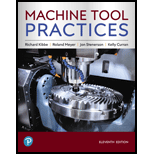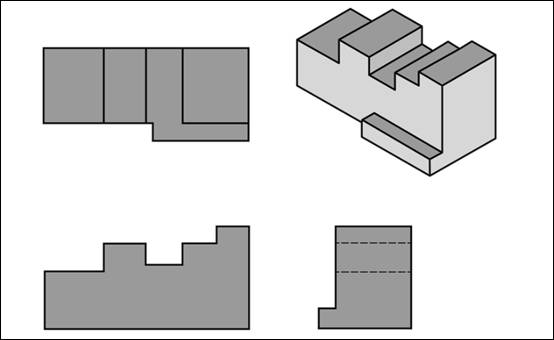
Pearson eText for Machine Tool Practices -- Instant Access (Pearson+)
11th Edition
ISBN: 9780137409129
Author: Richard Kibbe, Roland Meyer
Publisher: PEARSON+
expand_more
expand_more
format_list_bulleted
Question
Chapter A.6, Problem 10ST
To determine
The missing lines for the three views of the following figure.

Expert Solution & Answer
Want to see the full answer?
Check out a sample textbook solution
Students have asked these similar questions
Q5: A 5.6 litre V8 engine with a compression ratio of 9.4:1 operates on an air-standard
Otto cycle at 2800 RPM, with a volumetric efficiency of 90 % and a stoichiometric
air-fuel ratio using gasoline. The exhaust flow undergoes a temperature drop of
44ºC as it passes through the turbine of the supercharger. Calculate (a) mass flow
rate of exhaust gas and (b) power available to drive the turbocharger compressor.
do handwritten
Create a report: An example
of two people who do not
understand each other due
to lack of communication,
and mention ways to
resolve the issue between
them .
Chapter A Solutions
Pearson eText for Machine Tool Practices -- Instant Access (Pearson+)
Ch. A.1 - Prob. 1STCh. A.1 - Prob. 2STCh. A.1 - Companies are looking for people with good...Ch. A.1 - Prob. 4STCh. A.1 - Prob. 5STCh. A.1 - Prob. 6STCh. A.1 - Prob. 7STCh. A.1 - Prob. 8STCh. A.2 - Prob. 1STCh. A.2 - Prob. 2ST
Ch. A.2 - Prob. 3STCh. A.2 - Prob. 4STCh. A.2 - Prob. 5STCh. A.2 - Prob. 6STCh. A.2 - Prob. 7STCh. A.3 - What is the primary piece of safety equipment in...Ch. A.3 - Prob. 2STCh. A.3 - Prob. 3STCh. A.3 - Prob. 4STCh. A.3 - What hazards exist from coolants, oils, and...Ch. A.3 - Prob. 6STCh. A.3 - Prob. 7STCh. A.3 - Prob. 8STCh. A.3 - Prob. 9STCh. A.3 - Prob. 10STCh. A.3 - Prob. 11STCh. A.4 - Define the term pitch diameter.Ch. A.4 - Name two ways to measure a thread.Ch. A.4 - What is the rule of thumb for the length of...Ch. A.4 - Describe when class two fits are used.Ch. A.4 - Describe UNC and UNF.Ch. A.4 - What is the formula for calculating the OD of a...Ch. A.4 - When are stud bolts used?Ch. A.4 - Prob. 8STCh. A.4 - Explain two reasons why flat washers are used.Ch. A.4 - What is the purpose of a helical spring lock...Ch. A.4 - When is an internal-external tooth lock washer...Ch. A.4 - When are dowel pins used?Ch. A.4 - When are taper pins used?Ch. A.4 - When are roll pins used?Ch. A.4 - What are retaining lings?Ch. A.4 - Prob. 16STCh. A.4 - Prob. 17STCh. A.4 - Prob. 18STCh. A.5 - Prob. 1STCh. A.5 - Prob. 2STCh. A.5 - Prob. 3STCh. A.5 - Prob. 4STCh. A.5 - Prob. 5STCh. A.5 - Prob. 6STCh. A.6 - Prob. 1STCh. A.6 - Prob. 2STCh. A.6 - Prob. 3STCh. A.6 - Prob. 4STCh. A.6 - Prob. 5STCh. A.6 - Prob. 6STCh. A.6 - Prob. 7STCh. A.6 - Prob. 8STCh. A.6 - Prob. 9STCh. A.6 - Prob. 10STCh. A.7 - Prob. 1STCh. A.7 - Prob. 2STCh. A.7 - Prob. 3STCh. A.7 - Prob. 4STCh. A.7 - Prob. 5STCh. A.7 - Prob. 6STCh. A.7 - Prob. 7STCh. A.7 - Prob. 8STCh. A.7 - Prob. 9STCh. A.7 - Prob. 10STCh. A.8 - Prob. 1STCh. A.8 - Prob. 2STCh. A.8 - Prob. 3STCh. A.8 - Prob. 4STCh. A.8 - Prob. 5STCh. A.8 - Prob. 6STCh. A.8 - Prob. 7STCh. A.8 - Prob. 8STCh. A.8 - Prob. 9STCh. A.8 - Prob. 10STCh. A.8 - Prob. 11STCh. A.9 - Prob. 1.1QCCh. A.9 - Prob. 1.2QCCh. A.9 - Prob. 1.3QCCh. A.9 - Prob. 1.4QCCh. A.9 - Prob. 1.5QCCh. A.9 - Prob. 1.6QCCh. A.9 - Prob. 2.1QCCh. A.9 - Prob. 2.2QCCh. A.9 - Prob. 3.1QCCh. A.9 - Prob. 3.2QCCh. A.9 - Prob. 4.1QCCh. A.9 - Prob. 4.2QCCh. A.9 - Prob. 4.3QCCh. A.9 - Prob. 1STCh. A.9 - Prob. 2STCh. A.9 - Prob. 3STCh. A.9 - Prob. 4STCh. A.9 - Prob. 5STCh. A.9 - Prob. 6ST
Knowledge Booster
Similar questions
- I want the kinematic diagram to be draw like this plsarrow_forwardAccording to the principles and steps above, draw the kinematic diagram of following mechanisms. Mark the appropriate scale, calculates the degree of freedom. NO.1 NO.2 NO: 3 NO.: 4arrow_forwardAn office building is planned with a lateral-force-resisting system designed for earthquake resistance in aseismic zone. The seismic capacity of the proposed system, expressed as a force factor, is assumed tofollow a lognormal distribution with a median of 6.5 and a standard deviation of 1.5. The ground motionfrom the largest expected earthquake at the site is estimated to correspond to an equivalent force factor of 5.5.(a) What is the estimated probability that the building will experience damage when subjected to the largest expected earthquake? (b) If the building survives (i.e., experiences no damage) during a previous moderate earthquake with aforce factor of 4.0, what is the updated probability of failure of the building under the largest expectedearthquake?(c) Suppose future occurrences of the largest expected earthquake follow a Poisson process with a mean return period of 500 years. Assuming that damage events from different earthquakes are statisticallyindependent,…arrow_forward
- During a plant visit, it was noticed that a 12-m-long section of a 10-cm-diameter steam pipe is completely exposed to the ambient air. The temperature measurements indicate that the average temperature of the outer surface of the steam pipe is 75°C when the ambient temperature is 5°C. There are also light winds in the area at 10 km/h. The emissivity of the outer surface of the pipe is 0.8, and the average temperature of the surfaces surrounding the pipe, including the sky, is estimated to be 0°C. Determine the amount of heat lost from the steam during a 10-h-long work day. Steam is supplied by a gas-fired steam generator that has an efficiency of 80 percent, and the plant pays $1.05/therm of natural gas. If the pipe is insulated and 90 percent of the heat loss is saved, determine the amount of money this facility will save a year as a result of insulating the steam pipes. Assume the plant operates every day of the year for 10 h. State your assumptions.arrow_forwardAn old fashioned ice cream kit consists of two concentric cylinders of radii Ra and Rb. The inner cylinder is filled with milk and ice cream ingredients while the space between the two cylinders is filled with an ice-brine mixture. Ice cream begins to form on the inner surface of the inner cylinder. To expedite the process, would you recommend rotating the inner cylinder? Justify your recommendation. icecream/ ice-brine Ra Rbarrow_forwardFind temperatures STRICTLY USING RITZ APPROXIMATION METHODarrow_forward
- Solve this Problem using RITZ APPROXIMATION. STEP BY STEParrow_forwardB/40 The body is constructed of a uniform square plate, a uniform straight rod, a uniform quarter‐circular rod, and a particle (negligible dimensions). If each part has the indicated mass, determine the mass moments of inertia of the body about the x‐, y‐, and z‐axes. Answer Given.arrow_forward(read image) Answer:arrow_forward
- (read image) Answer Givenarrow_forwardB/16. The plane area shown in the top portion of the figure is rotated 180° about the x‐axis to form the body of revolution of mass m shown in the lower portion of the figure. Determine the mass moment of inertia of the body about the x‐axis. Answer Givenarrow_forward(read image) Answer:arrow_forward
arrow_back_ios
SEE MORE QUESTIONS
arrow_forward_ios
Recommended textbooks for you
 Elements Of ElectromagneticsMechanical EngineeringISBN:9780190698614Author:Sadiku, Matthew N. O.Publisher:Oxford University Press
Elements Of ElectromagneticsMechanical EngineeringISBN:9780190698614Author:Sadiku, Matthew N. O.Publisher:Oxford University Press Mechanics of Materials (10th Edition)Mechanical EngineeringISBN:9780134319650Author:Russell C. HibbelerPublisher:PEARSON
Mechanics of Materials (10th Edition)Mechanical EngineeringISBN:9780134319650Author:Russell C. HibbelerPublisher:PEARSON Thermodynamics: An Engineering ApproachMechanical EngineeringISBN:9781259822674Author:Yunus A. Cengel Dr., Michael A. BolesPublisher:McGraw-Hill Education
Thermodynamics: An Engineering ApproachMechanical EngineeringISBN:9781259822674Author:Yunus A. Cengel Dr., Michael A. BolesPublisher:McGraw-Hill Education Control Systems EngineeringMechanical EngineeringISBN:9781118170519Author:Norman S. NisePublisher:WILEY
Control Systems EngineeringMechanical EngineeringISBN:9781118170519Author:Norman S. NisePublisher:WILEY Mechanics of Materials (MindTap Course List)Mechanical EngineeringISBN:9781337093347Author:Barry J. Goodno, James M. GerePublisher:Cengage Learning
Mechanics of Materials (MindTap Course List)Mechanical EngineeringISBN:9781337093347Author:Barry J. Goodno, James M. GerePublisher:Cengage Learning Engineering Mechanics: StaticsMechanical EngineeringISBN:9781118807330Author:James L. Meriam, L. G. Kraige, J. N. BoltonPublisher:WILEY
Engineering Mechanics: StaticsMechanical EngineeringISBN:9781118807330Author:James L. Meriam, L. G. Kraige, J. N. BoltonPublisher:WILEY

Elements Of Electromagnetics
Mechanical Engineering
ISBN:9780190698614
Author:Sadiku, Matthew N. O.
Publisher:Oxford University Press

Mechanics of Materials (10th Edition)
Mechanical Engineering
ISBN:9780134319650
Author:Russell C. Hibbeler
Publisher:PEARSON

Thermodynamics: An Engineering Approach
Mechanical Engineering
ISBN:9781259822674
Author:Yunus A. Cengel Dr., Michael A. Boles
Publisher:McGraw-Hill Education

Control Systems Engineering
Mechanical Engineering
ISBN:9781118170519
Author:Norman S. Nise
Publisher:WILEY

Mechanics of Materials (MindTap Course List)
Mechanical Engineering
ISBN:9781337093347
Author:Barry J. Goodno, James M. Gere
Publisher:Cengage Learning

Engineering Mechanics: Statics
Mechanical Engineering
ISBN:9781118807330
Author:James L. Meriam, L. G. Kraige, J. N. Bolton
Publisher:WILEY